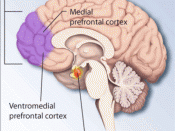Self mutilation is a broad term for a "complex group of behaviors resulting in destruction of one's own tissue. These behaviors including burning the skin, scratching the skin with abrasive objects such as bottle caps, pieces of glass and actual razor blades, pulling out the hair, breaking of bones, amputation and eye nucleation. These behaviors can have a variable assortment of causes (Timofeyev, Sharff, Outterson, & Burns, 2002). This paper will review the factors that increase the risk of self injury, examine the two major categories of self mutilation, and possible courses of treatment for those suffering through self mutilation.
There are many different factors that could potentially increase the risk of self injury. The age of the individual is a factor, as most people who self injure are teenagers. The act of self mutilation usually begins in the early teen years, when emotions are more erratic. Life issues also play a part in self mutilation.
Sexual, physical or emotional abuse as children or as adults can lead to self injury, as well as those who have experienced neglect in childhood. Mental health issues also plays a large part in self mutilation and those individuals who experience many negative emotions and are highly self critical are some that are at the highest risk for self injury. These individuals have not learned a healthy outlet for their emotions and rely on "cutting" in order to feel an instant sense of relief. Most people who self-injure tend to be perfectionists. They seem to be unable to handle intense feelings and are unable to express their emotions verbally. Usually they have a dislike for themselves and for their bodies, and can experience severe mood swings (Thompson, 2010).
.
Self mutilation is commonly associated with certain mental illnesses such as Borderline Personality Disorder, Depression, Anxiety Disorders, Post Traumatic Stress Disorder, Substance Abuse Disorders and Eating Disorders. People who self injure are more likely to be impulsive; the question of the impulsivity of self-injury is an important one. Like many other coping mechanisms SI occurs when a person needs it, so it may occur without forethought. If a person feels the need to hurt themselves and there is nothing to stop them, they will probably hurt themselves. At times they may be in a situation where it isn't "safe" to hurt themselves (school, work, etc.), but they are unable to control their impulses, in other words, sometimes the need to hurt themselves is greater than the risk involved with being caught doing so.Acts of self mutilation that are impulsive are more difficult to control. On the other hand, self mutilation acts that take more planning and premeditation are easier to manage or control (Alderman, 2001). Therefore, it is easier to control self injurious behaviors that are not impulsive.
There are two major categories found in self injurious behaviors. The first is those self injurious behaviors that are involved in culturally sanctioned self mutilation. This category has two sub-types, rituals and practices. Cultural rituals imply activities that are repeated in a consistent manner over at least several generations and that reflect traditions, symbolism and beliefs of a society, such as the Sun Dance of the Plains Indians in which they gaze at the sun and struggle to break free of skewers that are inserted through both their back and their chest muscles. Practices imply activities that may be faddish and hold little underlying significance, such as piercing the ears or any other body part.
The other category is deviant pathological self mutilation. This category is divided to three categories, Major, Stereotypic and Moderate/Superficial. Major self injurious behavior refers to infrequent acts such as eye nucleation, castration and limb amputation. These acts result in the destruction of significant body tissue, and tend to be quite messy. They occur suddenly with a great deal of tissue damage and bleeding. These acts are not essential symptoms of any disorder but may appear as associated features. They are most commonly associated with psychosis (acute psychotic episodes, schizophrenia, mania and depression, and acute intoxication). One example of major self mutilation in a psychotic person is a 41 year old man who believed that he was pregnant and had to become the bride of Jesus, so he castrated himself completely.
Stereotypic self mutilation consists of the person banging their head, pushing in on their eyeballs and biting themselves when under emotional stress or anger. This type of self mutilation is highly prevalent in institutionalized mentally retarded patients. This type of self mutilation is often called Self Injurious Behavior, or SIB. SIB may also present as a symptom of Schizophrenia, acute psychosis and other disorders.
Finally there is Moderate/Superficial self mutilation. This type of self mutilation is characterized by skin cutting and burning. Other behaviors in this category include hair pulling, and skin scratching, picking, and carving, and are the most common forms of self mutilation. There are three types of Moderate/Superficial self mutilation, the compulsive, the episodic and the repetitive. They appear as symptoms of a number of disorders, and a case can be made that the repetitive self mutilation syndrome is itself a disorder of impulse control (Wolman, 2004).
Compulsive self mutilation occurs many times daily and is repetitive or ritualistic. Two examples of compulsive self mutilation are hair pulling, in which the individual will pull out their hair, usually from the scalp, eyebrows and eyelashes. This behavior usually begins in childhood, are present equally in boys and girls necessarily imply a severe intrapsychic or familial psychopathology. Hair pullers are usually not consciously aware of their behavior, and may do it without actually thinking about it. Another example is Psycho dermatological conditions. These are skin disorders associated with psychological and neurological factors. Individuals have delusions of parasites in their skin and therefore harm themselves in an effort to dig out the imaginary parasites or to destroy them with toxic substances such as bleach or lye. There are many disorders that may cause a person to have tactile hallucinations. Chronic users of cocaine, amphetamine and Ritalin as well as those suffering from alcohol withdrawal are among some of the sufferers. Medical disorders such as multiple sclerosis and hyperthyroidism may also cause tactile hallucinations.
Episodic self mutilation refers to behaviors that occur every so often. Individuals suffering from episodic self mutilation do not brood about their behavior and they don't identify as a cutter or a burner. They harm themselves deliberately in order to get relief from distressing thoughts or emotions and to regain a sense of self control. Tension release, an effort to "return to reality", to establish control, and to vent anger are some of the situations in which patients have reported that the behavior operates. Episodic self mutilation is best considered a symptom or associated feature of a mental disorder such as bi-polar disorder or generalized anxiety disorder.
Episodic self mutilation becomes repetitive self mutilation when the behavior becomes an overwhelming preoccupation in people who have been identified as a "cutter" or a "burner." These individuals describe themselves as addicted to their own self harm. There are not a set number of self mutilative episodes that mark the switch from episodic to repetitive. Unlike episodic, which is the repetitive type is considered a separate disorder of impulse control that is known as the repetitive self mutilation syndrome. It usually begins in early adolescence and persists for decades. During this time period the self harm will get worse then subside and may coexist with other impulse behaviors such as eating disorders, alcohol and substance abuse and kleptomania.
The most effective treatment of self-injury is a combination of medication, cognitive/behavioral therapy, and interpersonal therapy, supplemented by other treatment services as needed. Medication is often useful in the management of depression, anxiety, obsessive-compulsive behaviors, and the racing thoughts that may accompany self-injury. Cognitive/behavioral therapy helps individuals understand and manage their destructive thoughts and behaviors. Contracts, journals, and behavior logs are useful tools for regaining self-control. Interpersonal therapy assists individuals in gaining insight and skills for the development and maintenance of relationships. Services for eating disorders, alcohol/substance abuse, trauma abuse, and family therapy should be readily available and integrated into treatment, depending on individual needs ("Self injury: warning," 2010).
Self mutilation affects a wide array of individuals and is almost impossible to attach to any one disorder or mental illness. Self mutilation can be chronic, lasting for the entirety of a Sufferer's life. With medication and therapy we can assist those that self mutilate with understanding their behavior and helping them to find alternative methods of expressing emotions, perhaps ending the process for one sufferer at a time.
References
Timofeyev, Alexander, Sharff, Katie, Outterson, Nora, & Burns, Rachel. (2002). What is self mutilation. why does it happen?. Retrieved from http://wso.williams.edu/~atimofey/self_mutilation/Definition/What_is/index.html
Thompson, Colleen. (2010, July 30). Self injury. Retrieved from http://www.mirror-mirror.org/selfinj.htm
Alderman, Tracy. (2001). Scarred soul: understanding and ending self inflicted violence . Oakland, CA: Harbinger Publications
Mayo Clinic: Self-injury/cutting:risk factors. (2010, August 3). Retrieved from http://www.mayoclinic.com/health/self-injury/DS00775/DSECTION=risk-factors
Favazza, Armando. (1992). Bodies under siege. Baltimore, MD: The Johns Hopkins University Press.
Self injury: warning signs. (2010). Retrieved from http://www.nmha.org/index.cfm?objectid=C7DF983B-1372-4D20-C800C76DEFCBAE2F
Self Mutilation 1
Self Mutilation; A Review of the Disease
Stacey A. Christianson
Psychology 215
Professor Bolger
December 10, 2010


